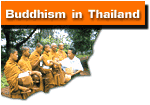 Ayutthaya Period Ayutthaya Period |
 Towards the close of the
nineteenth Buddhist century which witnessed the decline
of Sukhothai kingdom, King U-thong of Suphunaphum, once
under Sukhothai domination, proclaimed his state as
independent of Sukhothai power and built up his capital
at a town called Sri Ayutthaya, south of Sukhothai.
This kingdom, which lasted 417 years, are ruled over
by 33 kings. Towards the close of the
nineteenth Buddhist century which witnessed the decline
of Sukhothai kingdom, King U-thong of Suphunaphum, once
under Sukhothai domination, proclaimed his state as
independent of Sukhothai power and built up his capital
at a town called Sri Ayutthaya, south of Sukhothai.
This kingdom, which lasted 417 years, are ruled over
by 33 kings.
Through more than four
centuries which marked the age of Ayutthaya kingdom,
Theravada Buddhism in Thailand seemed to reach its zenith
of popularity. Within and without the city of Ayutthaya
there scattered innumerable temples and pagodas which
served as places, thereby exerting a great influence
on the spiritual life of the people. Buddhist art, both
in the field of architecture and Buddha-image construction,
were on the same line of flourishing. An illustrative
example of this fact may be seen today in the temple
of the Foot-Prints at Saraburi. There was also a tradition
which is still in practice today for every Thai young
man to be ordained at least once as a bhikkhu. Several
kings such as Pra Borom Trai Lokanatha, the 18th king,
in following the example set by King Li-Thai of Sukhothai
period, had temporarily renounced his throne to be ordained
as a bhikkhu.
During the reign of Phra
Borom-Kote, the thirty-first of Ayutthaya kingdom, there
reigned in Ceylon a king named Kitti-Siri-Raj-Singha,
who being discouraged by the decline of Buddhism in
his island country and learning that Buddhism was purer
in Thailand than any other country, sent forth his religious
mission to the Thai King, asking a favour of some Thai
bhikkhus to revive the spirit of Theravada Buddhism
which had almost died out in his land. This was a good
occasion when Thailand was able to repay her debt to
Ceylon and the Venerable Upali, together with his followers,
were sent to Ceylon. Thus the community of Ceyl;onese
bhikkhus ordained by the Thai bhikkhus at that time
has ever since been called Upali-Vangsa or Siam-Vangsa.
It is the well known and most revered sect in Ceylon.
Religious literature of
Ayutthaya, however, abounded both in Pali and Thai language,
but most of them were most regretfully destroyed when
the kingdom was ruthlessly overrun by the enemy in 2310
BE. |



 Towards the close of the
nineteenth Buddhist century which witnessed the decline
of Sukhothai kingdom, King U-thong of Suphunaphum, once
under Sukhothai domination, proclaimed his state as
independent of Sukhothai power and built up his capital
at a town called Sri Ayutthaya, south of Sukhothai.
This kingdom, which lasted 417 years, are ruled over
by 33 kings.
Towards the close of the
nineteenth Buddhist century which witnessed the decline
of Sukhothai kingdom, King U-thong of Suphunaphum, once
under Sukhothai domination, proclaimed his state as
independent of Sukhothai power and built up his capital
at a town called Sri Ayutthaya, south of Sukhothai.
This kingdom, which lasted 417 years, are ruled over
by 33 kings.